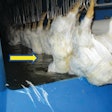.jpg?auto=format%2Ccompress&q=70&w=400)
In today’s broiler industry, a constant eye needs to be kept on the variables that can affect quality, safety and profit. This is important at each of the various stages that make up the production, processing and storage cycles prior to sending product to clients to ensure that anything that may have negative impact is kept properly under control.
Cold storage is an important part of that chain, and there are numerous factors that need to be closely watched.
1. The temperature at which birds enter the cold room is critical, and should not exceed 4 degrees C. Deviation from this can have the following repercussions:
Slower refrigeration and/or freezing, due to the need to remove greater quantities of heat from the product;
Making extraction equipment work harder to remove the additional heat, will result in higher operational costs;
The time to reach the desired temperature will increase, and this can result in bottlenecks in the production process that could lead to the temporary suspension of a plant’s operation. An example of these difficulties is that if product does not reach the required temperature in time, the room cannot be emptied. If the room cannot be emptied in time product further back the process must wait, so risking a rise in their temperature and a loss of weight.
Crates will not be ready to transport, disinfection and delivery to the packing area.
2. Packaging much completely adhere to the product to prevent the formation of air pockets. These can result in condensation, resulting in a “snow”, that can give a product an appearance of being old. The dimensions of any packaging should fully take into account the final state of a product, so that the packaged product in its final state is preserved as a single compact unit.
3. The packaged chicken should be placed in a crate that has been properly cleaned and disinfected to prevent possible cross contamination problems. Crates should not be over-filled as any contact points between birds will not freeze properly and result in quality problems.
4. Crates should not be so highly filled that air cannot pass easily between them. Additionally, over-filled crates will result in birds being damaged when one crate is stacked upon another.
5. Columns of stacked crates should, ideally, be kept on plastic pallets within the cold room and these pallets should have a minimum height of 10 cms to allow the free flow of air that is pushed by the fan of the evaporators to the lower part of the crates closest to the floor.
6. The arrangement of the stacks within the cold room is particularly important. They must be arranged so as to leave a gap around the edge of some 10 cms, aligned with the air flows from the evaporators. This will allow the air to move freely, facilitating the removal of heat from the birds and achieve a rapid cooling within a set time.
7. Refrigeration or freezing is a continuous cycle of heat removal. Cold air heats up as it crosses the product. The area below the evaporator, however becomes the warmest part of the room as it is where the warm air accumulates. Because of this, no product whatsoever should be stored here, especially giblets as, due to their high fat content, quickly oxidize and deteriorate.
8. When storing loose product, exposing it directly to the cold should be avoided as this can result in surface drying problems, commonly known as “freezer burn”. Because of this dehydration, not only is quality greatly affected but also profit. It should be remembered that 70% of muscular tissue is water.
9. The temperature in the cold room should be kept as constant as possible. Changes can result not only in a deterioration in quality, but also profits if there is a resumption of bacterial activity.
10. Doors, whether manual or automatic, much be quick and easy to operate. They should be completely airtight to prevent warmer air from the outside entering and causing problems. Ensuring that the room is tightly sealed can help to prevent any crystallization occurring under the product’s packaging.
11. Curtains made from PVC strips should be hung with sufficient overlap to prevent the entrance of air from the outside. In some establishments, double curtains with a 50% overlap have been installed. In addition, there are also curtains that work automatically when the cold room doors are opened.
Curtaining is important as warm air entering from the outside can form a mist. This can freeze on the fan blades of the evaporators and the evaporative panel and reduces efficiency.
12. Whenever the cold room doors are closed lighting should be switched off. There are a number of benefits to this, including: saving energy, extending the life of bulbs, and the elimination of a source of heat.
















